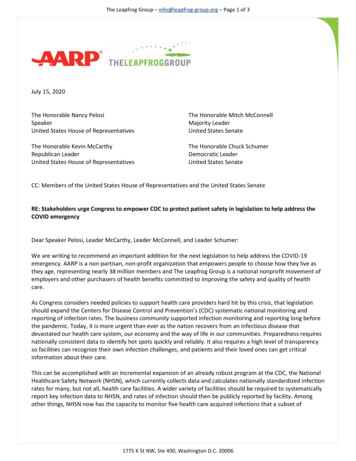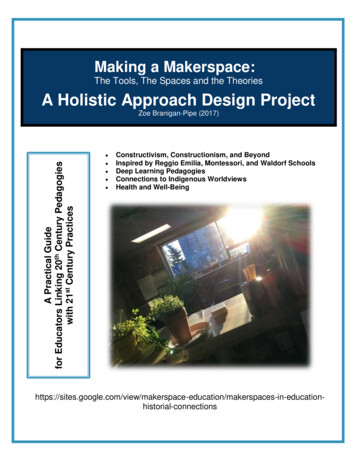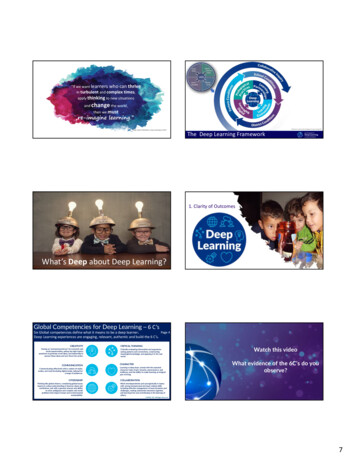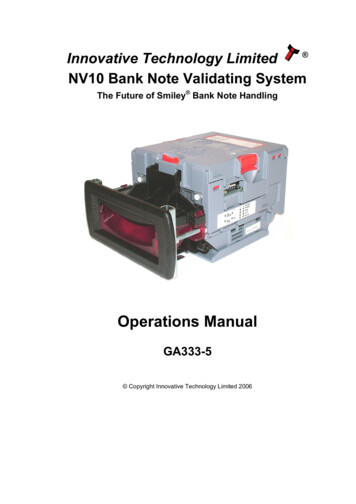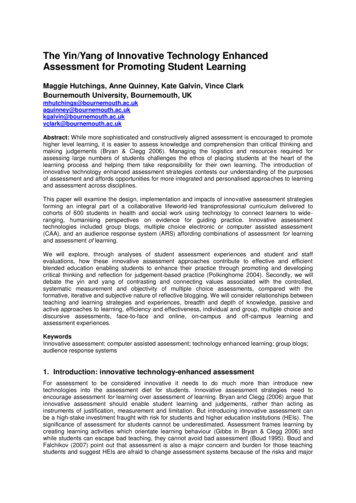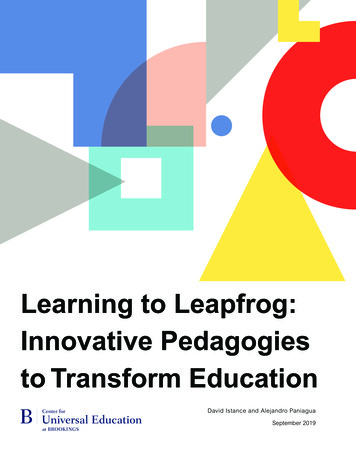
Transcription
Learning to Leapfrog:Innovative Pedagogiesto Transform EducationDavid Istance and Alejandro PaniaguaSeptember 2019
LEARNING TO LEAPFROG: INNOVATIVE PEDAGOGIES TO TRANSFORM EDUCATIONAuthorsDavid Istance is a nonresident senior fellow at the Brookings Institution and former senioranalyst at the Centre for Educational Research and Innovation of the Organisation forEconomic Co-operation and Development (OECD).Alejandro Paniagua is a former elementary school teacher, teacher educator, and associateprofessor at the University of Barcelona and, until recently, a consultant to the OECD.AcknowledgmentsWe are grateful to the many people who have provided valuable insights during theresearch process and writing of this report. First, we would like to thank the researchand editorial team at the Center for Universal Education at Brookings, includingRebecca Winthrop, Lauren Ziegler, Katherine Portnoy, Nicolas Zerbino, Rachel Brisson,Rhea Handa, and Foluyinka Fakoya.We would also like to thank our colleagues and friends who provided feedback andcomments on the report, including Elizabeth King, Jenny Perlman Robinson, Ju-Ho Lee,Francisco Benavides, Urvashi Sahni, John Bangs, and Emiliana Vegas.The Brookings Institution is a nonprofit organization devoted to independent research andpolicy solutions. Its mission is to conduct high quality, independent research and, basedon that research, to provide innovative, practical recommendations for policymakers andthe public. The conclusions and recommendations of any Brookings publication are solelythose of its author(s), and do not reflect the views of the institution, its management, or itsother scholars.Brookings gratefully acknowledges the support provided by the BHP Foundation and theLEGO Foundation.Brookings recognizes that the value it provides is in its commitment to quality,independence, and impact. Activities supported by its donors reflect this commitment.
TABLE OF CONTENTS1. The Leapfrog Imperative: There is an Urgent Need for Future-Ready Teaching and Learning3The Aims of This Report5A Global Spotlight on Learning6Leapfrogging to More Ambitious Heights9The Innovation Imperatives: Meet Global Goals, Cope with Change, Redress Inequalities11Leapfrogging Learning: Why Pedagogy is So Important11The Burden of Proof132. Innovative Pedagogies Are Essential for Leapfrogging14Understanding Pedagogy to Improve Teaching14Mapping the Landscape with Clusters of Innovative Pedagogies15Using Pedagogical Clusters to Illuminate Leapfrogging Pathways15Blended Learning: Using Online Learning to Teach to the Right Level16Computational Thinking: Computing to Improve Problem-Solving Skills18Experiential Learning: Involving Students in Their Communities22Embodied Learning: Engaging with Crafts and Creativity25Multiliteracies: Fostering Bi/Multilingual Education28Gamification: Storytelling to Immerse Students in the Flow of Learning31Implementing Innovative Pedagogies: Moving Beyond Classroom Walls333. Three Structural Changes Are Needed for Innovative Pedagogies to Flourish36Investing in the Foundations of Quality Teaching36Widening the Profile of Educators42Supporting Hybrid Learning Environments454. Scaling Deep Change is Required to Transform Teaching and Learning52Scaling Innovative Pedagogies Requires a Focus on Deep Change53Education Networks Have the Power to Scale Deep Change54The Meso Level is Critical for Leapfrogging575. Conclusion606. Endnotes617. Bibliography691
LEARNING TO LEAPFROG: INNOVATIVE PEDAGOGIES TO TRANSFORM EDUCATIONList of FiguresFigure 1.1 The Leapfrog Pathway4Figure 1.2 Enrollment Rates in Primary and Secondary Education, by Country Income Group7Figure 1.3 Primary School Students Above Minimum Proficiency in Mathematics and Reading,by Country Income Group8Figure 1.4 The Role of Pedagogy10Figure 2.1 The Six Clusters of Innovative Pedagogies15Figure 2.2 Blended Learning on the Pedagogical Continuum17Figure 2.3 Computational Thinking on the Pedagogical Continuum20Figure 2.4 Experiential Learning on the Pedagogical Continuum22Figure 2.5 Embodied Learning on the Pedagogical Continuum25Figure 2.6. Multiliteracies on the Pedagogical Continuum28Figure 2.7 The “Flow State” as a Fundamental Pedagogical Goal31Figure 2.8 Gamification on the Pedagogical Continuum32Figure 2.9 Teaching Innovation Requires Moving Beyond Classroom Walls35Figure 3.1 Foundations of Quality Teaching37Figure 3.2 Trained Teachers, by Level of Schooling and World Region38Figure 3.3 Widening the Profile of Educators43Figure 3.4 Hybrid Learning Environments46Figure 4.1 Scaling Deep Change54Figure 4.2 The Meso Layer of Education55Figure 4.3 Three Dimensions of Scaling Up Meso-Level Network Innovation58List of BoxesBox 2.1Blended Learning Literacy Instruction in Elementary Education in the United States18Box 2.2African School for Excellence: Providing Quality Education at a Lower Cost19Box 2.3Unplugged Activities: Computational Thinking Skills without Computers21Box 2.4Education for Sustainability Service Learning in Nigeria23Box 2.5Our Lady’s and St. Mochua’s Primary School:Providing a Pathway to the Future of Rural Communities24Box 2.6Engaging 3D Experiences for Canadian First Nations Students26Box 2.7Makerspaces That Integrate Art and Real-World Learning27Box 2.8Perspectives for a Diverse America: Teaching for Tolerance29Box 2.9Bilingual Education in Peru: “Translanguaging” Quechua30Box 2.10Storytelling to Improve Mathematics Teaching in Greece33Box 2.11Papilio: Storytelling, Puppets, and Play to Foster Social and Emotional skills in Preschool Children 342
Section 1The Leapfrog Imperative:There Is an Urgent Need forFuture-Ready Teaching andLearningThis report follows up on the book “LeapfroggingInequality: Remaking Education to Help Young PeopleThrive,” published in 2018 by the Center for UniversalEducation (CUE) at the Brookings Institution. The bookargued the importance of education leapfrogging–creating transformative shifts rather than incrementalevolution by harnessing the power of innovation toadvance a breadth of skills.1 The book put forth aframework for leapfrogging (figure 1.1) that outlinedtwo core elements (teaching and learning, and recognition of learning) and two support elements (peopleand places, and technology and data).This report focuses on the teaching and learningelement of the leapfrog framework, especially onpedagogical approaches and the role of teachers, butdraws on the others as relevant. It does not attempt tobe exhaustive and does not pretend to address neitherall education policy variables, nor critical systemfactors such as political will and adequate funding,nor demand-side factors such as student and parentsupport for innovative approaches.We join an international clamor of concern summedup recently as “the learning crisis.”2 For a long time,the main route to improving learning has been perceived to be in widening education access, giving allcountries the universal levels of participation enjoyedby the well-resourced systems of the developed world.This remains to be fully achieved, especially for certainsections of the populations that are systematicallyexcluded. However, now that much progress has beenachieved globally in extending access, new fundamental questions are being raised. Do children andyoung people acquire sufficient levels of knowledgeand competencies during their years of education,and what do they learn? Are the foundations being laidin the early years, when young people normally attend3
LEARNING TO LEAPFROG: INNOVATIVE PEDAGOGIES TO TRANSFORM EDUCATIONFigure 1.1The Leapfrog PathwayCORE ELEMENTSTeaching and Learning: Increasingly Student-CenteredPOTENTIAL TOLEAPFROGLEAPEvaluate and Create Apply andAnalyze Remember and UnderstandInteractive Lecture-basedSKIPLEARNINGApply and Analyze Remember andUnderstandLecture-basedHOPTEACHINGRemember and UnderstandPlayful Interactive Lecture-basedRecognition of Learning: Increasingly IndividualizedIndividual-based Group-based PredeterminedLEAPVERIFICATIONIndustry-led Hybrid-led Education-ledGroup-based PredeterminedSKIPPOTENTIAL TOLEAPFROGHybrid-led ledSUPPORT ELEMENTSPeople and Places: Increasingly DiverseLEAPEveryone Teachers team with others Licensed teachersPLACESIn a diversity of contexts Connected to outside school In-schoolTeachers team with others Licensed teachersSKIPPOTENTIAL TOLEAPFROGConnected to outside school In-schoolLicensed teachersHOPPEOPLEIn-schoolTechnology and Data: Increasingly Results OrientedLEAPAugmentation SubstitutionSKIPDATAData for transforming learning experiences Data for program improvement Data forcomplianceData for program improvement Datafor compliancelSubstitutionData for complianceModification and redefinition Augmentation Substitution4POTENTIAL TOLEAPFROGHOPTECHNOLOGY
school, on which to base lifetimes of further learning?A leapfrogging through learning transformation is required to address the gravity of the current crisis.of transformation that this vision implies for educationsystems, and how to think about fruitful near-term approaches for scaling up innovative pedagogies.The Aims of This ReportNaturally, this report drew on existing literature, especially on pedagogies, teaching, and learning. Weused the foundational analysis of pedagogy established through our earlier work for the Organisation forEconomic Co-operation and Development (OECD),“Teachers as Designers of Learning Environments,”including the six clusters of innovative pedagogical approaches.3 We also drew on the insights andframeworks of parallel CUE work on breadth of skills,curriculum, and scaling. In this report, we use theterms “21st century skills,” “breadth of skills,” and“transversal skills” interchangeably, as no single precise definition is appropriate to our analysis.The overall goal of this report is to deepen insights onhow to leapfrog. Specifically, this report focuses onwhat might be done to address the learning crisis andto transform education systems to meet the demandsof tomorrow. The report’s value-added is its sharppedagogical focus and its twin themes: Pedagogical innovation is critical and is at theheart of the ambition to leapfrog education systems. This is especially true for learning by childrenand young people, but also true for learning byteachers. It is critical to learn from the experiences ofexisting transformative approaches—what theyhave achieved and how they did it—to clarify howinnovative, powerful forms of learning can bespread and sustained, especially under challenging circumstances.The report first reviews the nature of the problem andargues that the global lifelong learning agenda callsfor serious reimagining of the education landscape.It then argues that pedagogy, and specifically innovative pedagogies, must be central to any systematictransformation if leapfrogging is to be achieved. Thereport identifies six clusters of such pedagogieswhich, alone or in combination, would underpin sucha transformation. (We used the shorthand “innovativepedagogies,” but we could have used other terms,including “playful” or “engaging.”) The report thenexamines factors that enable the successful implementation of innovative pedagogies, homing in on thesupport and empowerment of teachers, as well asstructural changes in the design of schools to includehybrid models, combining both formal and nonformal.Finally, the report concludes by reflecting on the depthA major resource for this report was the “Global Catalog of Education Innovations,” developed by CUEalongside the 2018 Leapfrogging book,4 a compilationof nearly 3,000 cases from around the world. We alsoreviewed cases in the broader literature, including respondents to a 2019 PlayFutures survey. We narroweddown the cases by searching for those in teaching,learning, and pedagogy (specifically, those tagged as“playful learning”) and with at least basic evaluativeevidence of impact. And, given our focus on schoolage learners, we excluded the examples in higher andadult education and training.We recognize that the Catalog has limitations ofcomparability. Each of the “innovation spotter” organizations contributing cases used its own definitions andmethodologies. The information represents a snapshotof the situation at the time the case reports were puttogether; each case will have developed since then,and some may have been discontinued altogether. Weare less concerned with the precise histories of eachof the hundreds of Catalog innovations, and muchmore concerned with the models and practices theyshow are possible.5
LEARNING TO LEAPFROG: INNOVATIVE PEDAGOGIES TO TRANSFORM EDUCATIONWe aim to shape understanding through our analytic frameworks and to inspire, including through theinnovation cases themselves. The readership that weseek to inform and inspire are those with a policy andstakeholder interest in education around the world.Some will be education officials in local and nationalgovernments, and others will be in leadership positions in schools, associations, and networks. Some willbe promoting change through teacher organizations,nongovernmental organizations (NGOs), intergovernmental organizations, and foundations. Others will bethe academic experts who engage with contemporarychange.A Global Spotlight on LearningFor the first time, in 2018, the World Bank devotedits annual “World Development Report” exclusivelyto education, illustrating the high priority assigned toeducation in the global policy discourse. The report’stitle, “Learning to Realize Education’s Promise,” indicates that a great deal remains to be done to translate investments and participation in education intodeep-seated learning. The report argues that countries and stakeholders must be open not only to learning about innovation, but also to innovating learning, tostand a chance of realizing education’s potential.5The report notes the dramatic improvements made inaccess to education over the years, highlighting that,“[i]n 1970, the gross primary enrollment rate was 68percent in sub-Saharan Africa and 47 percent in SouthAsia. By 2010, that rate was above 100 percent in bothregions The recent expansion in schooling in low-income countries is especially remarkable in its scopeand speed.”6The report’s authors are not complacent, recognizingthat even the struggle to educate all children is farfrom won in many locations and that globally, “hundreds of millions of youth remain out of a school.”7But, many countries around the world have made6decisive steps to increase access to education, evenif much of it is still low quality, especially in Africa andLatin America.8 Since the start of the 21st century,many countries of different income levels have recorded a rise in school enrollments, but with differing gradients (figure 1.2). The upper-middle-income countrieshave closed the gaps with the richest countries, especially in enrollments at the primary level. But not allgradients are upward: enrollments in the low-incomecountries have flatlined in recent years.Widening Learning InequalitiesCaveats notwithstanding, there is much to applaudabout increased access to schooling globally. Butthe World Bank’s main concern, expressed as “thelearning crisis,” is the substantial gap between attendance in schools and the actual learning taking placein many countries and communities. “Children learnvery little in many education systems around the world:even after several years in school, millions of studentslack basic literacy and numeracy skills.”9 In Mozambique and Nigeria, for example, after more than threeyears of compulsory language education, 80 percentof students cannot read simple words of Portugueseand English, respectively.10 In Uganda, half of the poorchildren are still in school at age 14 but they are threeor more years behind grade level.11The consequence is gaps in minimum proficiency inmathematics and reading between high-income andthe other sets of countries (upper-middle, lower-middle, and low-income), as shown in figure 1.3. Whilethere is a clear gap in proficiency between low- andhigh-income countries, it is also possible to see differences between the high- and upper-middle-incomecountries, on the one hand, and the lower-middle andlow-income countries. These are by no means simplyNorth-South inequalities.The mass schooling systems of the developed countries also face significant challenges of education
Figure 1.2Enrollment Rates in Primary and Secondary Education, by Country Income Group100Percentage e Secondary80High-IncomeUpper-middle IncomeLower-middle e: World Bank Education Statistics (2019).Note: Enrollments are measured by “net enrollment rates,” defined by the World Bank as, “Total number of students in the theoretical age group for educationlevel enrolled in that level, expressed as a percentage of the total population in that age group.”7
LEARNING TO LEAPFROG: INNOVATIVE PEDAGOGIES TO TRANSFORM EDUCATIONunderperformance and inequality.12 Across the European Union, more than 10 percent of children leaveschool at the lower secondary education level or evenearlier, and remain outside education and training.13And, while average per-student expenditures increased by 17 percent between 2005 and 2013 in thehigh-income OECD countries, Programme for International Student Assessment (PISA) data show nosignificant improvement in test scores over the sameperiod.14 In PISA participating countries, one-third of15-year-olds do not reach minimum proficiency levelsin reading.15issue, and (2) the amplification of inequality, which“severely hobbles the disadvantaged youth who mostneed the boost that a good education can offer.”16Inherent in this learning crisis is the stark reality thata great deal of teaching, including in the high-income countries, is not succeeding in embedding theknowledge, skills, and dispositions that societies andeconomies demand. Moreover, the distribution of thisfailure is highly unequal. This state of affairs makesleapfrogging all the more urgent, but it also underscores the scale of the task: to first stop the tide, andthen to reverse it, with a veritable sea change.There is thus a double crisis: (1) the lack of learningdespite attendance at school, which is a basic qualityFigure 1.3Primary School Students Above Minimum Proficiency in Mathematics and Reading,by Country Income Group100Percentage806040200Mathematics Low IncomeUpper-middle IncomeReading Lower-middle IncomeHigh IncomeSource: WDR 2018 team, using “A Global Data Set on Education Quality” (2017).Note: Bars show unweighted cross-country median within country grouping. Minimum proficiency in mathematics is benchmarked by TIMSS assessment andPIRLS assessment is used for reading. Country income levels are as defined by the World Bank8
Wider Economic and Social InequalitiesBroader trends of inequality impact on the inequalitiesin education. Income inequality today is at its highestlevel since the 1980s.17 This has a direct effect oneducation, because, “much empirical research findsthat countries with higher levels of income inequalitytend to show lower levels of social mobility acrossgenerations [and that] disparities in performancerelated to socio-economic status develop early andwiden throughout students’ lives.”18 These patterns areespecially marked in certain regions; in Latin Americancountries, for instance, income inequality is greater and social mobility is less prevalent than in mostOECD countries.19Therefore, the global expansion of education hastaken place in the context of income inequalities thatare already wide and widening further, which education has barely dented so far. The shift in systems ofeducation from elite to mass to universal has been atriumph, but as we have seen, it has not resolved thelearning crisis.20 Nor could expansion of educationby itself bring about greater income equality, for asmore students access one level of education, the keyfilters move upwards; those left behind are even moreexcluded, while those who move up the rungs of theeducation ladder find no guarantees of the expectedpayoffs. In any case, the aim should not be for somesocial groups or individuals to move ahead of others,without altering inequality. Rather, the goal should befor whole countries or sections of the population tomove up, thereby closing gaps and narrowing inequalities—in other words, leapfrogging inequality.Leapfrogging to More AmbitiousHeightsThe challenge of leapfrogging becomes even moredaunting because of the continual growth in globalambitions about what education can achieve. Wefocus here on three mega-ambitions that reveal theupward pressure of global expectations: the breadthand depth of skills agendas, 2030 targets, and lifelonglearning. Far from standing still, the goals are beingexpanded in bold new directions. The challenge is toensure that this extension does not leave those whoare already behind, still further behind, and more surely out of reach.Ambitious Agendas for Breadth and Depth of SkillsIncreasingly, the focus has turned to what should belearned during childhood and adolescence, combinedwith the realization that many school curricula havebeen heavily dominated by academic knowledge. Inan era of rapid change, this is seen as limited andold-fashioned. The argument for breadth of skills isclearly summarized in the 2018 Leapfrogging book:Many educators argue that the best way for schoolsto prepare young people for future success is tohelp them develop a broad range of learning, work,and life skills that they can deploy all their lives,regardless of what the future entails. This does notmean jettisoning academic learning, but it doesmean using teaching and learning approachesthat enable students to delve deeply into subjects,while also fostering a range of what some refer to as“21st century skills.” At the core, education systemsmust move from prioritizing knowledge acquisitionto prioritising both knowledge acquisition and thedevelopment of skills needed to use that knowledgeeffectively in new contexts over time.21This passage shows the ambition of the breadth ofskills agenda, in which breadth refers to the manydifferent skills and capacities now needed. Even moreambitious, breadth cannot be at the expense of depth,because the 21st century skills needed for problemsolving and knowledge transfer depend on deep understanding. These are very ambitious extensions ofthe goals of education.9
LEARNING TO LEAPFROG: INNOVATIVE PEDAGOGIES TO TRANSFORM EDUCATIONFigure 1.4The Role of sThe SDG’s education targets are demanding of teaching and of teachers, in insisting that education shouldbe high quality and equitable and should includerelevant work skills, as well as contribute directly tosustainable development. Beyond the targets that explicitly address education, education is also expectedto contribute fully to the other SDGs, in such areas asthe elimination of poverty, promoting good health andwell-being, enhanced productivity and innovation, andthe promotion of peace and justice.The Ambition of Lifelong LearningThese ambitions have come to define curricula aroundthe world. A parallel CUE study concludes that “thereis compelling evidence of a shift in education systemstoward broadening education provision beyondtraditional disciplines and focus on literacy and numeracy.”22 One of the reasons to focus so strongly on pedagogies and learning, as we argue below, is becauseof the gap between the broad competence-basedvisions and curricula and the actual learning takingplace in classrooms Pedagogy, therefore, acts as abridge between principles and practice (figure 1.4).Ambitious 2030 TargetsExpectations in all countries for children, their rights,and their opportunities, have risen notably over thepast three decades or so. A very tangible expressionof the increasing ambitions for education are theSustainable Development Goals (SDGs), which theinternational community set in 2015 for achievementby 2030. The targets most directly related to educationare grouped together under Goal Area 4. They cover: universal pre-primary, primary, and secondaryeducation universal youth literacy and numeracy gender equality and inclusion equal access to technical, vocational, and highereducation and relevant skills for decent work education for sustainable development, peace,human rights, and global citizenship2310Lifelong learning is theoverarching global goalThe lifelong learningthat has been widelyagenda implies wideendorsed by the globalranging changescommunity for the past24in the organizationquarter century. Thisgoal is relatively easyof education andto endorse, difficult tolearning—that is, it callsformulate with precision,for deep innovation.and still more challenging to implement.The SDGs and the breadth of skills movements aremanifestations of this global lifelong learning goal. The1996 Delors report, for instance, laid out an articulatebreadth of skills agenda that embraced knowledge,self-realization, skills, and the capacity to pursueharmonious social relationships.25 The lifelong learningagenda implies wide-ranging changes in the organization of education and learning—that is, it calls for deepinnovation.Realizing lifelong learning goes well beyond educationministries and even well beyond formal policymaking.Its realization is as dependent on the foundation laidduring the early years of childhood and adolescenceas it is on creating opportunities beyond schooling.And since lifelong engagement in learning relies soheavily on the actions and designs of communitiesand individuals, these individuals must be equipped
during childhood and adolescence with the values,attitudes, and habits to continue to learn. This includesengagement in learning and playfulness. These arenot warm cozy notions of little relevance to the seriouschallenges of education leapfrogging; rather, they arefundamental elements of this foundation for lifetimes oflearning. The Innovation Imperatives: MeetGlobal Goals, Cope with Change,Redress InequalitiesThe learning crisis coupled with the high (and rising)global expectations for education are the first mainreason for the innovation imperative.26 Widespreadinnovation in education is required to make a seriousdent in learning inequalities and to make progress toward implementing lifelong learning, 21st century curricula, or meeting the ambitious sustainability targetsby 2030. Furthermore, this innovation must take placein the mainstream of schooling, and not be confined totinkering around the experimental margins.Second, innovation is imperative because of the rapidchanges underway in the economy, in skill demands,and in society. This argument has an immediate political resonance, because all can recognize the facts ofrapid change in technology, skills obsolescence, global relations, and social behavior and hence the needfor education to respond to these changes.27 However,it is much easier to acknowledge the facts of changethan to identify how to respond to them, because theygive conflicting signals about which directions to movein. On the one hand, rapid change argues for promoting student flexibility and adaptability, while on theother hand, an individual’s stability must be anchoredin identity and a sense of belonging, to withstandturbulence. Inherent in both is depth of understandingand reflection. Thus, innovation to equip children andadolescents to respond to change arguably can beseen as heading in different directions at the sametime, to promote:Flexibility and adaptability, defined as the abilityto make connections, to adapt methods creatively,and to solve unfamiliar problemsDeep understanding, rather than a broad superficial introduction to a large volume of content.This means both mastery of knowledge as well asfacility with the processes of learning.A solid ethical, social, and cultural foundationso that individuals can cope, and even thrive, withinstability and turbulenceIn addition to the innovation needed in educationsystems to achieve these qualities at scale, innovationmust disproportionately affect those whose educationachievements are lowest—in each country, and globally—if the innovation is to leapfrog inequality.Leapfrogging Learning:Why Pedagogy is So ImportantPedagogies to Address the Quality of LearningPedagogies are located in the engine room of education. Here, the core elements of learners, educators, content, and learning resources come togetherthrough pedagogies and assessment practices,different uses of educational time, and educatorsand learners working collaboratively or individually indifferent ways.28 Far-reaching transformation in education implies changes in the conditions under whichthe core elements are able to work.29 Unless there istransformation within pedagogy itself, however, theseother changes will have only very limited impact onactual student learning. For example, introducing achange to learning resources, such as computers ortablets, will not impact student learning if educators’teaching practices remain unchanged. Additionally,pedagogical innovations that improve breadth anddepth of skills also address access to and participation in education, because they are designed toengage those students most affected by educationinequalities. 3011
LEARNING TO LEAPFROG: INNOVATIVE PEDAGOGIES TO TRANSFORM EDUCATIONEvans and Popova, in their global review, “What ReallyWorks to Improve Learning in Developing Countries?An Analysis of Divergent Findings in SystematicReviews,” found marked differences in recommendations and suggested “that these divergent conclusionsare largely driven by differences in the samples ofresearch incorporated by each review.”31 Suc
2 LEARNING TO LEAPFROG: INNOVATIVE PEDAGOGIES TO TRANSFORM EDUCATION List of Figures Figure 1.1 The Leapfrog Pathway 4 Figure 1.2 Enrollment Rates in Primary and Secondary Education, by Country .
